Your information base for Oracle Forms to APEX Migration
Why Modernization?
 The shift towards modernizing applications is evident. According to the 2023 Gartner CIO and Technology Executive Survey, a significant percentage is prioritizing application modernization and cloud platforms as well as recognizing the importance of staying current with technology trends. Read more ⇓
The shift towards modernizing applications is evident. According to the 2023 Gartner CIO and Technology Executive Survey, a significant percentage is prioritizing application modernization and cloud platforms as well as recognizing the importance of staying current with technology trends. Read more ⇓
Risks can get you into technical, economic and strategic trouble. Examples are: failures, delays, maintainability issues, security vulnerabilities, compatibility issues, sudden modernization pressures, technical or application incompatibility, numerically and functionally limited capabilities, avoidable costs and other impacts.
We therefore strongly recommend that you consider modernizing your application at an early stage. You can achieve a lot with your application even before modernization.
Risks can get you into technical, economic and strategic trouble. Examples are: failures, delays, maintainability issues, security vulnerabilities, compatibility issues, sudden modernization pressures, technical or application incompatibility, numerically and functionally limited capabilities, avoidable costs and other impacts.
We therefore strongly recommend that you consider modernizing your application at an early stage. You can achieve a lot with your application even before modernization.
Customer demands
 What motivates our customers to modernize? They want to connect their application to the cloud or mobile devices, or they need other systems architectures, functions, platforms, programs or processes. Many also want a cutting edge and easy-to-manage application. Some are let down by their legacy application. The reasons are very diverse.
What motivates our customers to modernize? They want to connect their application to the cloud or mobile devices, or they need other systems architectures, functions, platforms, programs or processes. Many also want a cutting edge and easy-to-manage application. Some are let down by their legacy application. The reasons are very diverse.
Find out what motivated our customer Savantage Solutions
Read more ⇓
- Legacy Technology: Oracle Forms, while once a popular choice for building enterprise applications, is now considered legacy technology. This means that it may lack modern features, integration capabilities, and support for newer platforms and devices.
- Maintenance and Support Costs: Maintaining and supporting Oracle Forms applications can be expensive, especially as organizations need to invest in skilled resources who understand the technology and can address issues that arise.
- Security and Data Protection Cost: increasing cost arises from the need to address vulnerabilities inherent in legacy infrastructure, protect against modern cyber threats, comply with regulatory requirements, safeguard sensitive data, and sustain ongoing security measures.
- Scalability and Performance: Legacy Oracle Forms applications may struggle to scale effectively to meet the growing demands of an organization. Performance issues can arise as user bases expand or as more complex functionality is added.
- Lack of Flexibility and Customization: Oracle Forms applications may lack the flexibility and customization options that modern businesses require. Making changes or adding new features can be time-consuming and costly.
- User Experience: With the rise of modern, intuitive user interfaces, Oracle Forms applications may fall short in providing a user-friendly experience. This can lead to user dissatisfaction and decreased productivity.
- Legacy Technology: Oracle Forms, while once a popular choice for building enterprise applications, is now considered legacy technology. This means that it may lack modern features, integration capabilities, and support for newer platforms and devices.
- Maintenance and Support Costs: Maintaining and supporting Oracle Forms applications can be expensive, especially as organizations need to invest in skilled resources who understand the technology and can address issues that arise.
- Security and Data Protection Cost: increasing cost arises from the need to address vulnerabilities inherent in legacy infrastructure, protect against modern cyber threats, comply with regulatory requirements, safeguard sensitive data, and sustain ongoing security measures.
- Scalability and Performance: Legacy Oracle Forms applications may struggle to scale effectively to meet the growing demands of an organization. Performance issues can arise as user bases expand or as more complex functionality is added.
- Lack of Flexibility and Customization: Oracle Forms applications may lack the flexibility and customization options that modern businesses require. Making changes or adding new features can be time-consuming and costly.
- User Experience: With the rise of modern, intuitive user interfaces, Oracle Forms applications may fall short in providing a user-friendly experience. This can lead to user dissatisfaction and decreased productivity.
Concerns about modernizing?
 The most common arguments put forward against modernization are the costs, the time required, the risk of disruption, compatibility problems, the loss of old functions in the new system and resistance to change. However, these concerns are completely unjustified and can be threatening for a company. Read more ⇓
The most common arguments put forward against modernization are the costs, the time required, the risk of disruption, compatibility problems, the loss of old functions in the new system and resistance to change. However, these concerns are completely unjustified and can be threatening for a company. Read more ⇓With careful planning, the right approach and an experienced project team, many of the potential concerns of modernizing an application can be addressed. It is important to anticipate the challenges and take appropriate action to ensure a smooth transition.
Modernization drastically reduces the ongoing costs for maintenance and further development. With the proven modernization approach of PITSS, you have 100% cost control over the modernization project at all times and can split the budget appropriately. The financial risk of an outdated application (e.g. failure, missing functions) is eliminated.
The majority of the modernization process is automated. The time required is therefore very manageable. The PITSS team can implement the modernization project together with the customer or independently. This means that the developers on the customer side can devote themselves almost entirely to their day-to-day business.
The step-by-step or cluster-by-cluster modernization approach of PITSS eliminates interruptions and compatibility problems.
Anyone wishing to transfer old, valued functions to the new application can do so. A corresponding adaptation is usually always possible.
The PITSS approach of gradual modernization and preparatory or accompanying workshops removes any fear of change. In the end, what remains is enthusiasm for a modern and user-friendly application.
With careful planning, the right approach and an experienced project team, many of the potential concerns of modernizing an application can be addressed. It is important to anticipate the challenges and take appropriate action to ensure a smooth transition.
Modernization drastically reduces the ongoing costs for maintenance and further development. With the proven modernization approach of PITSS, you have 100% cost control over the modernization project at all times and can split the budget appropriately. The financial risk of an outdated application (e.g. failure, missing functions) is eliminated.
The majority of the modernization process is automated. The time required is therefore very manageable. The PITSS team can implement the modernization project together with the customer or independently. This means that the developers on the customer side can devote themselves almost entirely to their day-to-day business.
The step-by-step or cluster-by-cluster modernization approach of PITSS eliminates interruptions and compatibility problems.
Anyone wishing to transfer old, valued functions to the new application can do so. A corresponding adaptation is usually always possible.
The PITSS approach of gradual modernization and preparatory or accompanying workshops removes any fear of change. In the end, what remains is enthusiasm for a modern and user-friendly application.
How to modernize?
 Choosing the right modernization strategy is crucial. Opting for the wrong approach can lead to inefficient and therefore expensive projects, wasted resources, missed deadlines, and unresolved issues within the application portfolio.
Choosing the right modernization strategy is crucial. Opting for the wrong approach can lead to inefficient and therefore expensive projects, wasted resources, missed deadlines, and unresolved issues within the application portfolio.To save a lot of time and money and get the agreed result in the desired quality it is essential to focus only on the valuable code of the legacy application and to generate as many fragments as possible for the new technology in collaboration with an expert. It is well known that the combination of experts and GenAI achieves the best results.
Read more ⇓
The optimal modernization process consists of 4 phases:
Phase 1: Preparation phase
Clean up your old application. Get rid of redundancy code, dead code, unused code, in short, everything that is not needed. Your application will then be lighter and clearer. Then determine all dependencies, processes, bottlenecks, problem areas, the complexity and quality of your application. Use evaluations and key figures for this. Already in the preparation phase, you bring the BL into the database. With our product, all these tasks can be carried out in a highly automated and error-free manner.
Phase 2: Migration phase
A cluster of the application is defined and formed from the measures and results of the preparation phase, according to best practice criteria and tailored to the customer-specific requirements. This cluster, as part of the application, is now migrated with our product from Oracle Forms to APEX. Your entire application is then broken down into clusters in order to implement the migration stepwise. At the end, you will have a fully migrated application in APEX.
Phase 3: Fine-tuning phase
In phases one and two, you can clean up and generate a large part automatically. However, some manual work remains and is ideally presented to you automatically via a ticket system. In the fine-tuning phase, you can complete the manual work in a guided way.
Phase 4: Roll-out phase
The migrated APEX cluster – later the entire new APEX application – is tested in the roll-out phase and – if everything fits – linked to your systems and activated. Nothing stands in the way of the successful deployment of your migrated new APEX application.
The optimal modernization process consists of 4 phases:
Phase 1: Preparation phase
Clean up your old application. Get rid of redundancy code, dead code, unused code, in short, everything that is not needed. Your application will then be lighter and clearer. Then determine all dependencies, processes, bottlenecks, problem areas, the complexity and quality of your application. Use evaluations and key figures for this. Already in the preparation phase, you bring the BL into the database. With our product, all these tasks can be carried out in a highly automated and error-free manner.
Phase 2: Migration phase
A cluster of the application is defined and formed from the measures and results of the preparation phase, according to best practice criteria and tailored to the customer-specific requirements. This cluster, as part of the application, is now migrated with our product from Oracle Forms to APEX. Your entire application is then broken down into clusters in order to implement the migration stepwise. At the end, you will have a fully migrated application in APEX.
Phase 3: Fine-tuning phase
In phases one and two, you can clean up and generate a large part automatically. However, some manual work remains and is ideally presented to you automatically via a ticket system. In the fine-tuning phase, you can complete the manual work in a guided way.
Phase 4: Roll-out phase
The migrated APEX cluster – later the entire new APEX application – is tested in the roll-out phase and – if everything fits – linked to your systems and activated. Nothing stands in the way of the successful deployment of your migrated new APEX application.
How to modernize with PITSS?
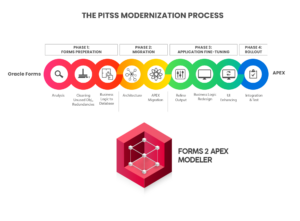 There is a perfect migration concept that will transform even a complex Oracle Forms application into a beautiful, completely modern, intuitive APEX Web application. Our approach for a perfect migration is the PITSS Modernization Process and the use of PITSS products to automate as much as possible. Read more ⇓
There is a perfect migration concept that will transform even a complex Oracle Forms application into a beautiful, completely modern, intuitive APEX Web application. Our approach for a perfect migration is the PITSS Modernization Process and the use of PITSS products to automate as much as possible. Read more ⇓Look forward to a smooth, swift and successful modernization project with the Forms2APEX Modeler and the PITSS modernization process!

The PITSS modernization process steps at a glance:
- Application Analysis
In this analysis phase the scope of the modernization project is calculated. The F2A Modeler is used to analyze the dependencies, clarify the infrastructure and identify the customer specifications. Because the application analysis is almost completely automated, the result of the analysis is of the highest quality, nothing is left out and everything is available at lightning speed.One result is a comprehensive project calculation that gives the customer certainty about the entire project budget. All of these values have been confirmed in all of our projects.
- Housekeeping
The application analysis provides the optimal basis for the first optimization steps. With the F2A Modeler, dead code is removed, redundancies are eliminated, specifications are implemented and the business logic is transferred to the database. Congratulations! You have made the most of your legacy application. For modernization, we are now moving on. - Business Process Analysis
The Business Process Analysis includes recording the various use cases of the application. In addition to the valuable documentation, which makes the application much clearer and easier to understand, this step makes it possible to redesign the application during modernisation into a more business process-oriented UX and to check whether some components of the legacy application are no longer necessary from a business perspective. - Architecture
Now that the preparation phase has been successfully completed and some optimization steps have already been taken, it’s time to focus on essential, technical core components. APEX provides in general new functionalities, modern UX, and a bunch of features to turn your legacy application into a brand new one. To start from the first day with consistent behavior of your app, at the end of this phase: The infrastructure is set up, the master app is defined, existing and new features are discussed and decided on, and coding guidelines are determined. The result is a best practice application architecture. - Fragment Generation
Once the optimum architecture is in place, you can start generating the application fragments. The F2A Modeler also supports you in this step. For the first time, the actual transformation from Forms to APEX takes place. In this step, you can heavily customize the way the fragments are generated, which means that a fragment from one customer will not look like another. - Create & Manage Tasks
The fine-tuning phase begins with the F2A modeler recording open tasks and creating tickets. These are presented to the developer inside a checklist, which also provides helpful context information (like similar objects, original code, relevant properties) to ease the work. In a management summary of those checklists the overall progress of the finetuning phase could be tracked. - Application Redesign
Once the open tickets have been processed, it is the turn of the User Interface (UI ) and User Experience (UX). In this phase the UI/UX modernization is the main task. Focus is a modern, responsive UI in APEX, leveraging its rich set of UI components and themes. - Enhancing
New functionalities are added or replace old ones. Any requirements left to security enhancements, accessibility and/or integration with external systems will be part of this step. - Integration & Testing
Integration and testing is a very important step in the migration from Forms to APEX. The new APEX application has to prove itself: that it is error-free, works seamlessly and meets the business requirements. External and internal system integration is also taken into account. If everything runs perfectly, you can start the roll-out. We wish you lots of fun and success with your new APEX application.
Look forward to a smooth, swift and successful modernization project with the Forms2APEX Modeler and the PITSS modernization process!

The PITSS modernization process steps at a glance:
- Application Analysis
In this analysis phase the scope of the modernization project is calculated. The F2A Modeler is used to analyze the dependencies, clarify the infrastructure and identify the customer specifications. Because the application analysis is almost completely automated, the result of the analysis is of the highest quality, nothing is left out and everything is available at lightning speed.One result is a comprehensive project calculation that gives the customer certainty about the entire project budget. All of these values have been confirmed in all of our projects.
- Housekeeping
The application analysis provides the optimal basis for the first optimization steps. With the F2A Modeler, dead code is removed, redundancies are eliminated, specifications are implemented and the business logic is transferred to the database. Congratulations! You have made the most of your legacy application. For modernization, we are now moving on. - Business Process Analysis
The Business Process Analysis includes recording the various use cases of the application. In addition to the valuable documentation, which makes the application much clearer and easier to understand, this step makes it possible to redesign the application during modernisation into a more business process-oriented UX and to check whether some components of the legacy application are no longer necessary from a business perspective. - Architecture
Now that the preparation phase has been successfully completed and some optimization steps have already been taken, it’s time to focus on essential, technical core components. APEX provides in general new functionalities, modern UX, and a bunch of features to turn your legacy application into a brand new one. To start from the first day with consistent behavior of your app, at the end of this phase: The infrastructure is set up, the master app is defined, existing and new features are discussed and decided on, and coding guidelines are determined. The result is a best practice application architecture. - Fragment Generation
Once the optimum architecture is in place, you can start generating the application fragments. The F2A Modeler also supports you in this step. For the first time, the actual transformation from Forms to APEX takes place. In this step, you can heavily customize the way the fragments are generated, which means that a fragment from one customer will not look like another. - Create & Manage Tasks
The fine-tuning phase begins with the F2A modeler recording open tasks and creating tickets. These are presented to the developer inside a checklist, which also provides helpful context information (like similar objects, original code, relevant properties) to ease the work. In a management summary of those checklists the overall progress of the finetuning phase could be tracked. - Application Redesign
Once the open tickets have been processed, it is the turn of the User Interface (UI ) and User Experience (UX). In this phase the UI/UX modernization is the main task. Focus is a modern, responsive UI in APEX, leveraging its rich set of UI components and themes. - Enhancing
New functionalities are added or replace old ones. Any requirements left to security enhancements, accessibility and/or integration with external systems will be part of this step. - Integration & Testing
Integration and testing is a very important step in the migration from Forms to APEX. The new APEX application has to prove itself: that it is error-free, works seamlessly and meets the business requirements. External and internal system integration is also taken into account. If everything runs perfectly, you can start the roll-out. We wish you lots of fun and success with your new APEX application.
Why PITSS?
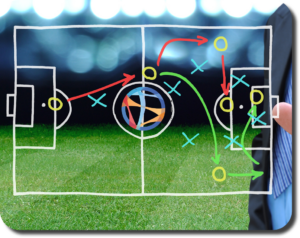 Using PITSS solutions offers a wide range of benefits, including improved efficiency, cost savings, enhanced performance, future-proofing against technology obsolescence, streamlined processes, reduced downtime, and optimization of Oracle technologies. Read more ⇓
Using PITSS solutions offers a wide range of benefits, including improved efficiency, cost savings, enhanced performance, future-proofing against technology obsolescence, streamlined processes, reduced downtime, and optimization of Oracle technologies. Read more ⇓Modernization of business critical and complex Oracle Forms applications is not a simple big bang migration but needs a customer tailored and stepwise project approach to ensure successful project result. PITSS understands the unique requirements, challenges, and goals of each customer and adjusts its solutions within the migration process accordingly. This ensures that the modernized Oracle Forms applications are precisely tailored to meet the customer’s needs.
Key to success:
- PITSS Expertise: business is made by people, perfect business is made by expert people with huge experience in development, architecture,technology and business – both for legacy application and target technologies such as APEX.
- PITSS Products: are built on 25+ years development including unique IP, know-how and experience for application management, analyses, migration and modernization and are proven in hundreds of successful projects globally. Continuous ongoing development ensures the incorporation of new features and functions that come with the latest technologies into the new architecture, guaranteeing a professionally maintained and up-to-date solution.
PITSS products are unique and a game changer in modernization projects.
- PITSS Methodology: The PITSS Modernization Process seamlessly combines expertise and product benefits, serving as the cornerstone and assurance of success for application modernization projects. PITSS understand customer needs, respect priorities and save investments taken in the past.
10 good reasons to modernize with PITSS:
- Entire view on the modernization project: big picture and full project scope before any project starts and based on a deep assessment.
- Reliable calculation instead of unsure estimation: results on the technical analyses metrics based for precise efforts calculation. View on 100% of the application code.
- Identification and management of technical debts, non used code and improving redundancies
- Fast results by stepwise modernization and effort calculation to APEX based on customer requirement
- Full control and documentation during the entire project phases: from Analyses to “GoLive”
- Quality improvement: code generator, 100% Oracle code, rules, code guidelines
- Tailored to customer specific application requirement
- Ensuring valid time and budget plans: full control of cost, effort and time
- Guided and documented process after conversion for perfect developer support
- Highly qualified and experienced experts at your side at every step of the modernization process
Modernization of business critical and complex Oracle Forms applications is not a simple big bang migration but needs a customer tailored and stepwise project approach to ensure successful project result. PITSS understands the unique requirements, challenges, and goals of each customer and adjusts its solutions within the migration process accordingly. This ensures that the modernized Oracle Forms applications are precisely tailored to meet the customer’s needs.
Key to success:
- PITSS Expertise: business is made by people, perfect business is made by expert people with huge experience in development, architecture,technology and business – both for legacy application and target technologies such as APEX.
- PITSS Products: are built on 25+ years development including unique IP, know-how and experience for application management, analyses, migration and modernization and are proven in hundreds of successful projects globally. Continuous ongoing development ensures the incorporation of new features and functions that come with the latest technologies into the new architecture, guaranteeing a professionally maintained and up-to-date solution.
PITSS products are unique and a game changer in modernization projects.
- PITSS Methodology: The PITSS Modernization Process seamlessly combines expertise and product benefits, serving as the cornerstone and assurance of success for application modernization projects. PITSS understand customer needs, respect priorities and save investments taken in the past.
10 good reasons to modernize with PITSS:
- Entire view on the modernization project: big picture and full project scope before any project starts and based on a deep assessment.
- Reliable calculation instead of unsure estimation: results on the technical analyses metrics based for precise efforts calculation. View on 100% of the application code.
- Identification and management of technical debts, non used code and improving redundancies
- Fast results by stepwise modernization and effort calculation to APEX based on customer requirement
- Full control and documentation during the entire project phases: from Analyses to “GoLive”
- Quality improvement: code generator, 100% Oracle code, rules, code guidelines
- Tailored to customer specific application requirement
- Ensuring valid time and budget plans: full control of cost, effort and time
- Guided and documented process after conversion for perfect developer support
- Highly qualified and experienced experts at your side at every step of the modernization process
Why APEX?
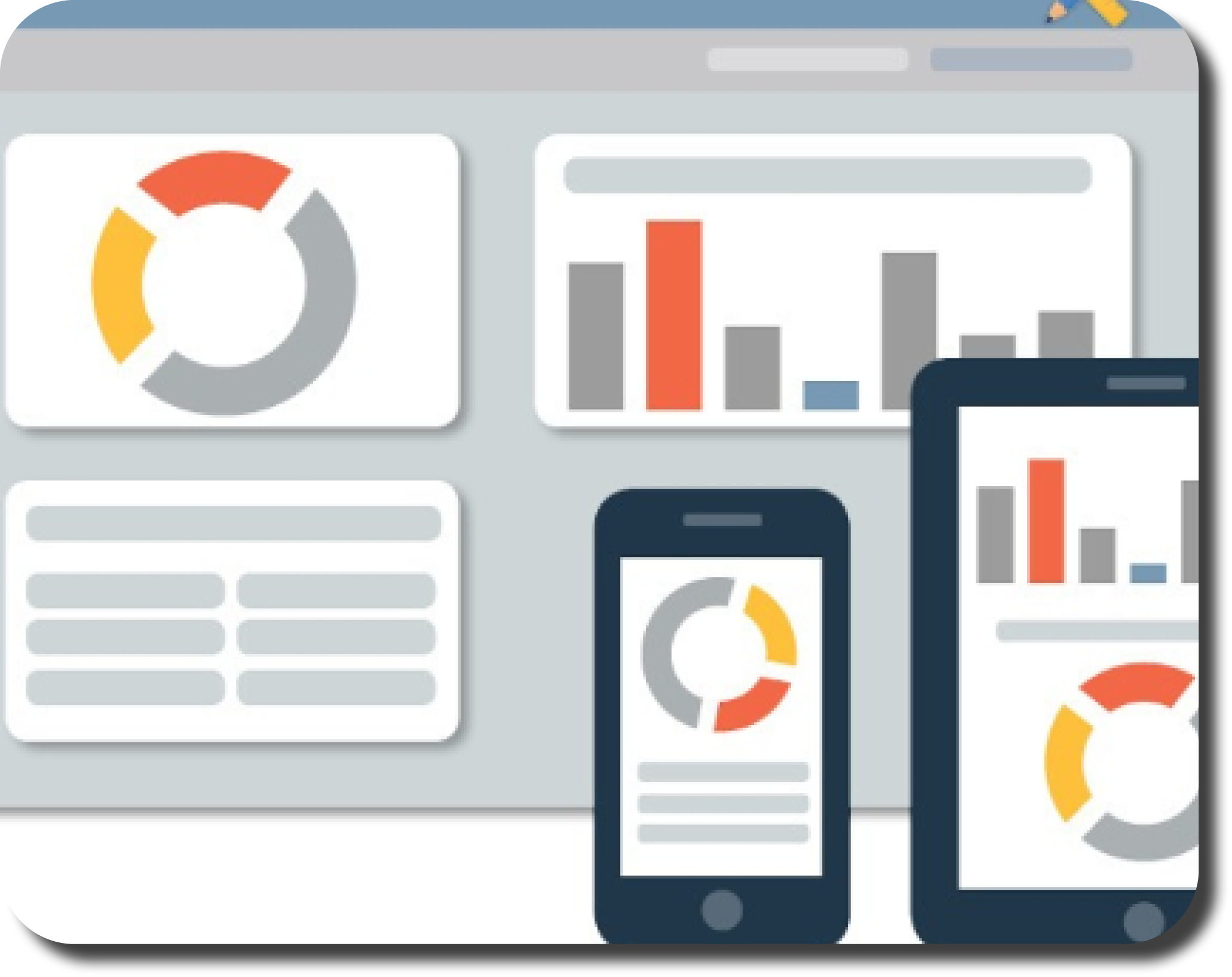 Oracle APEX is the clear platform of choice and recommended by Oracle for modernizing Oracle Forms applications. The same stored procedures and PL/SQL packages work natively in APEX, making it so simple to develop. Read more ⇓
Oracle APEX is the clear platform of choice and recommended by Oracle for modernizing Oracle Forms applications. The same stored procedures and PL/SQL packages work natively in APEX, making it so simple to develop. Read more ⇓
More than that, APEX presents notable advantages such as browser-based functionality, responsiveness, enhanced performance, user-friendliness, cost-effectiveness, and independence from client-side tools.
While Oracle Forms enjoyed popularity in the past and remains entrenched in the tech stacks of numerous companies, Oracle’s trajectory indicates a shift away from this technology. Its Premier Support status is nearing its end, signaling a timely opportunity for Oracle Forms users to explore migration options. Transitioning to Oracle APEX stands out as a particularly advantageous move in this scenario.
Why APEX for Oracle Forms customers at a glance?
- Less costs: Oracle APEX is a no-cost feature of Oracle Database
- Common skills: Similar technologies Forms & APEX
- Reuse: Database programs and business logic from Forms can used for APEX
- Coexistence: Oracle Forms and Oracle APEX can both run side-by-side
- Mobile: Oracle APEX apps are fully responsive and can be easily installed on your device of choice
- Modern UX: Oracle APEX apps are intuitive, easy to use, responsive, mobile friendly and similar to other modern cloud apps
- Proven way: Many Forms customers already migrated from Forms to APEX
More than that, APEX presents notable advantages such as browser-based functionality, responsiveness, enhanced performance, user-friendliness, cost-effectiveness, and independence from client-side tools.
While Oracle Forms enjoyed popularity in the past and remains entrenched in the tech stacks of numerous companies, Oracle’s trajectory indicates a shift away from this technology. Its Premier Support status is nearing its end, signaling a timely opportunity for Oracle Forms users to explore migration options. Transitioning to Oracle APEX stands out as a particularly advantageous move in this scenario.
Why APEX for Oracle Forms customers at a glance?
- Less costs: Oracle APEX is a no-cost feature of Oracle Database
- Common skills: Similar technologies Forms & APEX
- Reuse: Database programs and business logic from Forms can used for APEX
- Coexistence: Oracle Forms and Oracle APEX can both run side-by-side
- Mobile: Oracle APEX apps are fully responsive and can be easily installed on your device of choice
- Modern UX: Oracle APEX apps are intuitive, easy to use, responsive, mobile friendly and similar to other modern cloud apps
- Proven way: Many Forms customers already migrated from Forms to APEX
TREASURE BOX
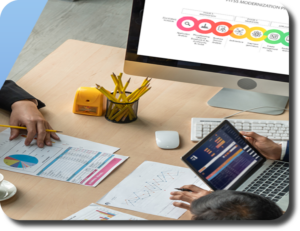
How to move from Oracle Forms
to APEX?
Oracle Forms 2 APEX Live
Experience Workshop
Experience an easy transition based on your source.
LEARN MORE
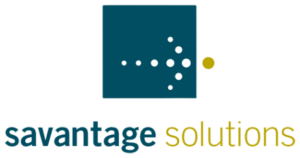
Success Story
Savantage Solutions
Oracle Forms to APEX – a joint success
READ MORE

How big is the effort to modernize?
Oracle Forms 2 APEX Analysis
Excellent facts and figures for the right decisions.
LEARN MORE
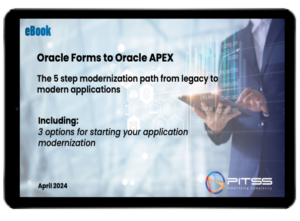
eBook
Oracle Forms to Oracle APEX
The 5 step modernization path
DOWNLOAD

What does the full project look like?
Application Assessment
Get a grip on your modernization project and bring it on the right track from the beginning.
LEARN MORE
Extended Info PITSS insights
Q&A
Q&A about Oracle Forms to APEX
Typical questions a customer may have in case of a modernization of an existing Oracle Forms Application to APEX.
Individual consulting
for the modernization of your software
Ask without obligation

Your contact
Sacha Sander
VP Global Sales
ssander@pitss.com

